
Deir ez-Zor is the largest city in eastern Syria and the seventh largest in the country. Located 450 km (280 mi) to the northeast of the capital Damascus on the banks of the Euphrates River, Deir ez-Zor is the capital of the Deir ez-Zor Governorate. In the 2004 census, it had a population of 211,857 people.

Armin Theophil Wegner was a German soldier and medic in World War I, a prolific author, and a human rights activist. Stationed in the Ottoman Empire during World War I, Wegner was a witness to the Armenian Genocide and the photographs he took documenting the plight of the Armenians today "comprises the core of witness images of the Genocide."

The deportation of Armenian intellectuals, sometimes known as Red Sunday, was the first major event of the Armenian Genocide. Leaders of the Armenian community in the Ottoman capital of Constantinople, and later other locations, were arrested and moved to two holding centers near Angora. The order to do so was given by Minister of the Interior Talaat Pasha on 24 April 1915. On that night, the first wave of 235 to 270 Armenian intellectuals of Constantinople were arrested. With the adoption of the Tehcir Law on 29 May 1915, these detainees were later relocated within the Ottoman Empire; most of them were ultimately killed. More than 80 such as Vrtanes Papazian and Komitas survived.
The Armenians in Syria are Syrian citizens of either full or partial Armenian descent.
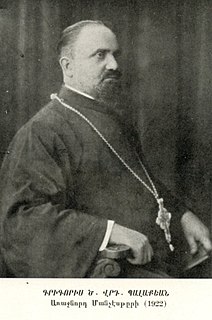
Grigoris Balakian 1875 – 8 October 1934), was a bishop of the Armenian Apostolic Church, in addition to being a survivor and memoirist of the Armenian Genocide.

Al-Baggara or Bakara An Arab tribe of the Euphrates tribes spread widely between Iraq, Syria, Jordan and Turkey. The tribe was named by the name of their grandfather, Imam Muhammad Al-Baqir, one of the grandsons of the faithful Ali ibn Abi Talib.

Karen Jeppe was a Danish missionary and social worker, known for her work with Ottoman Armenian refugees and survivors of the Armenian Genocide, mainly widows and orphans, from 1903 until her death in Syria in 1935. She was a member of Johannes Lepsius' Deutsche Orient-Mission and assumed responsibility for the Armenian children in the Millet Khan German Refugee Orphanage after the 1895 Urfa massacres.
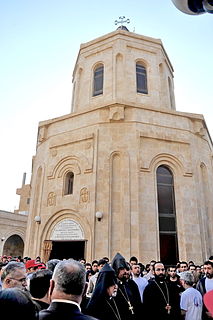
Armenian Genocide Martyrs' Memorial in Deir ez-Zor, Syria, was a complex dedicated to victims of the Armenian Genocide. The construction of the Martyrs' Memorial started in December 1989 and was completed in November 1990. It was consecrated on 4 May 1991 by Catholicos Karekin II of the Armenian Catholicosate of Cilicia. The memorial complex served as church, museum, monument, archive centre and exhibition. It was under the direct administration of the Armenian Prelacy, Diocese of Aleppo. Every year, on 24 April, tens of thousands of Armenian pilgrims from all over the world visited the Der Zor complex to commemorate the genocide victims, with the presence of their religious leaders.
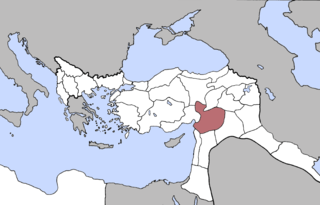
The Vilayet of Aleppo was a first-level administrative division (vilayet) of the Ottoman Empire, centered on the city of Aleppo.

Armenian–Syrian relations are foreign relations between Armenia and Syria. Armenia has an embassy in Damascus and a consulate general in Aleppo. In 1997, Syria opened an embassy in Yerevan. Syrian Foreign Minister Farouk al-Sharaa visited Armenia in March 1992.
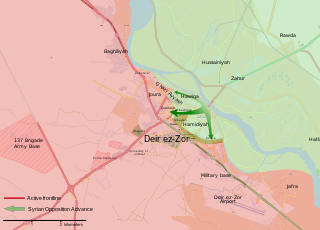
Protests against the Syrian government and violence had been ongoing in the Syrian city of Deir ez-Zor since March 2011, as part of the wider Syrian Civil War, but large-scale clashes started following a military operation in late July 2011 to secure the city of Deir ez-Zor. The rebels took over most of the province by late 2013, leaving only small pockets of government control around the city of Deir ez-Zor.
Ra's al-'Ayn camps were desert death camps near Ra's al-'Ayn city, where many Armenians were deported and slaughtered during the Armenian Genocide. The site became "synonymous with Armenian suffering".

Issam Jad'aan Zahreddine, also transliterated as Issam Zaher Eldin or Issam Zaher al-Deen, was a Major General of the Syrian Republican Guard who played a major role in the Syrian Civil War, leading Syrian government forces on several fronts. His most prominent role was the leadership of the surrounded Syrian forces during the over three-year long Siege of Deir ez-Zor. On 18 October 2017, Zahreddine was killed by a land mine explosion during operations against the Islamic State of Iraq and the Levant on Saqr island in Deir ez-Zor.
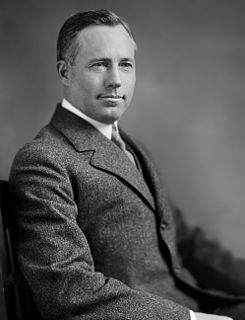
Jesse Benjamin Jackson was a United States consul and an important eyewitness to the Armenian Genocide. He served as consul in Aleppo when the city was the junction of many important deportation routes. Jackson concluded that the policies towards the Armenians were "without doubt a carefully planned scheme to thoroughly extinguish the Armenian race." He considered the "wartime anti-Armenian measures" to be a "gigantic plundering scheme as well as a final blow to extinguish the race." By September 15, 1915, Jackson estimated that a million Armenians had been killed and deemed his own survival a "miracle". After the Armenian Genocide, Jackson led a relief effort and was credited with saving the lives of "thousands of Armenians."

Armenian Diocese of Beroea, is one of the oldest dioceses of the Armenian Apostolic Church outside the historic Armenian territories, covering the Syrian city of Aleppo and the governorates of Deir ez-Zor, Idlib, Latakia and Raqqa. It is known as Beroea, being named after one of the ancient names of Aleppo; when the city was renamed Beroea (Βέροια) in 301 BC by Seleucus Nicator until the Arab conquest of Syria and Aleppo in 637 AD. The seat of the bishop is the Forty Martyrs Cathedral of Aleppo. It is under the jurisdiction of the Holy See of Cilicia of the Armenian Church.

The Deir ez-Zor offensive (2016) was an ISIL military operation, during which it took over the northern suburbs of Deir ez-Zor on 16 January 2016, and killed from 135 to 300 people, while also kidnapping about 400 others.
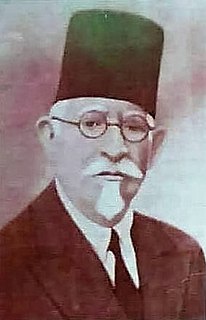
Haj Fadel Government was a government formed during the Occupation of Zor in the eastern region of Syria and based in Deir al-Zour`s city after the departure of the Ottomans in 1918, headed by Haj Fadel Al-Aboud and it was called his name.

Fadel Aboud Al-Hassan or Haj Fadel Al-Aboud a Syrian leader and head of the Haj Fadel government in eastern Syria after the Ottomans left the region in 1918.
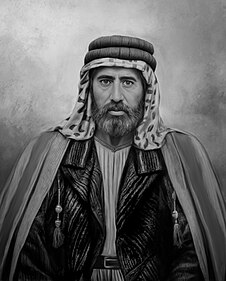
Ayyash Al-Haj Hussein Al-Jassim, a Syrian leader from Deir al-Zour city, began the armed struggle against the French colonizer in governorate of Deir al-Zour in 1925 coinciding with the outbreak of the Great Syrian Revolution in Jabal al-Arab and Ghouta of Damascus. He was sentenced by the French to exile to Jableh city with his family after they were convicted of planning and carrying out several military operations against the French forces, the latest was in "Ain Albu Gomaa". They also sentenced his eldest son Mohammed 20 years in prison on the island of Arwad, and executed his son Mahmoud by shooting with a number of other revolutionaries.























